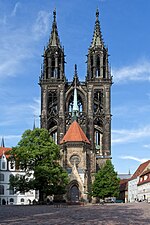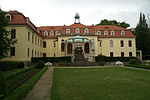Evangelical-Lutheran Church of Saxony
Christianity in SaxonyGermany stubsLutheran World Federation membersLutheranism in GermanyMember churches of the Protestant Church in Germany
The Evangelical-Lutheran Church of Saxony (Evangelisch-Lutherische Landeskirche Sachsens) is one of 20 member Churches of the Protestant Church in Germany (EKD), covering most of the state of Saxony. Its headquarters are in Dresden, and the seat of the bishop (styled Bishop of Saxony) is at Meissen Cathedral. Prior to the propagation of state atheism in the German Democratic Republic (East Germany), it was the largest Evangelical Lutheran church in Germany.The church has 610,503 parishioners in 319 parishes (as of December 31, 2022).
Excerpt from the Wikipedia article Evangelical-Lutheran Church of Saxony (License: CC BY-SA 3.0, Authors).Evangelical-Lutheran Church of Saxony
Burgterrasse,
Geographical coordinates (GPS) Address Website Nearby Places Show on map
Geographical coordinates (GPS)
| Latitude | Longitude |
|---|---|
| N 51.166111111111 ° | E 13.471388888889 ° |
Address
Burgberg Meißen
Burgterrasse
01662 , Altstadt
Saxony, Germany
Open on Google Maps









